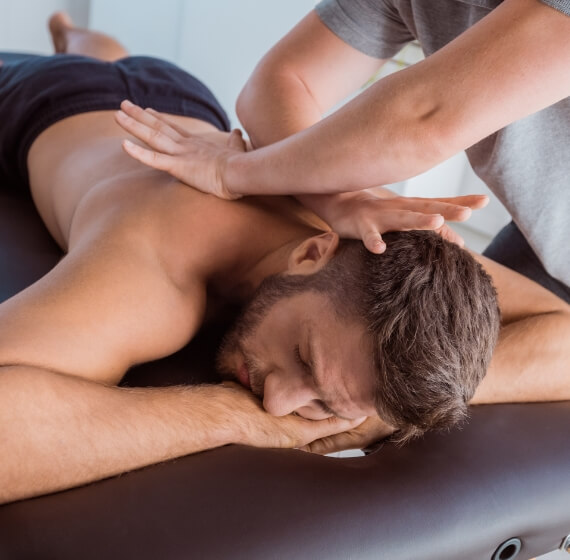
Massage Therapy in Croydon
When you think of a massage, you might picture it being exclusive to a posh spa. But at Croydon Sports Injury Clinic Ltd, we’re proud to offer gentle, focused, stress-relieving and therapeutic massage therapy designed to make you feel wonderful.
We use several techniques to target the problem areas and give you the results you need. Generally speaking, massage therapists press, stroke, and manipulate the muscles and other soft tissues of the body. They primarily utilise their hands and fingers, but may also use their forearms or elbows at times.
CONTACT US
Types of Massage Techniques
There are many massage techniques, these are the ones typically used in our practice
- Swedish – uses long strokes, kneading, circular movements, vibration, and tapping
- Sports – similar to Swedish, it’s modified specifically for the needs of athletes. Can be done pre- or post-workout
- Deep tissue – intense, deep pressure technique to relieve chronic muscle tension
- Trigger point – deeper focus on tight areas in muscles or “knots”, which are painful when pressed. Also works for muscle spasms. May create pain or other symptoms in different parts of the body
There are many other techniques which may prove beneficial for a particular patient. Your therapist is well-equipped to determine which therapies are best to address your condition, and produce the outcomes you’re looking for.
What to Expect
Massage therapy is most effective when the patient is relaxed, so your therapist usually begins with Swedish. Using a light lotion or oil, the therapist applies broad, flowing strokes to help relax your nervous system and alleviate muscle tension. As your body relaxes, pressure is slowly increased to relax certain areas and relieve muscular tension. Once your body is relaxed, the therapist may add additional techniques to get the desired results.
Some potential benefits may include
- Alleviates stress
- Reduces anxiety
- Decreases pain
- Improves sleep
- Increases blood circulation
- Reduces fatigue
- Increases joint flexibility
Frequently Asked Questions
How should I prepare for my massage therapy appointment?
There’s nothing in particular you need to do. Please arrive a few minutes before your session time. We will give you a form to fill out before you see the therapist. You’ll inform our therapist what issue has brought you in.
Is massage therapy appropriate for all ages?
Yes. In fact, infants may have massages, and also small children. And, of course, adults and seniors may also receive massage therapy.
Do I have to undress completely?
You elect to undress to your comfort level. Our therapist will accommodate your preference. If, for example, you’re just having your upper body addressed, you may choose to leave your pants on. If it’s an area the therapist needs to work on, those clothes need to be removed. Any other areas will be draped.
Why is massage therapy considered an important adjunctive service to chiropractic care?
When you have a misaligned joint, the muscles in the area will create forces on that misalignment, affecting its mobility. When the chiropractor adjusts the joints, they will move, but only to a certain point. The muscles may be restrictive if they’re particularly tight.
Receiving massage therapy before an adjustment helps the adjustment go deeper, and last longer, because the muscle tension has been released.
A massage should never be painful. A light, relaxing massage doesn’t probe deeply into the muscles and shouldn’t cause any discomfort. Pain may be a sign that the muscle might be injured or inflamed, and the amount of pressure should be modified. Pain may also cause you to tighten up and offset the relaxing effects of the massage. The most effective massage works with your body’s natural reaction.
Is there anything I should do after a deep tissue massage?
If you received a deep tissue massage, you may experience slight soreness the next day, similar to a good workout at the gym. If soreness lingers, a hot shower or soak in the tub may alleviate your discomfort. After your session, it’s a good idea to increase your water intake. We recommend you drink one or two extra glasses.
How often should I get a massage?
If you’re receiving massage therapy to help heal an injury or address chronic pain, you usually need to come in for weekly massage sessions, until you achieve that goal. For preventative, health maintenance, or to simply feel better, you have more choice in how often you receive massage. A regular massage can make a significant difference in your overall health, tension levels, and mental wellbeing.
Are there any medical conditions that would make massage inadvisable?
Yes. That’s why it’s critical that, before you start your session, the practitioner asks general health questions. It’s vital to advise the practitioner of any health issues or medications you are taking. If you’re under a doctor’s care, we advise you to obtain a written recommendation for massage before any session. Depending on the condition, it may be necessary to get approval from your doctor.
Book a Session
Book an appointment today and get ready to feel your best! Whether you’re an athlete or just enjoy recreational activities, we’re here to help. Experience the many benefits of the therapeutic techniques available at Croydon Sports Injury Clinic Ltd. Call today!



